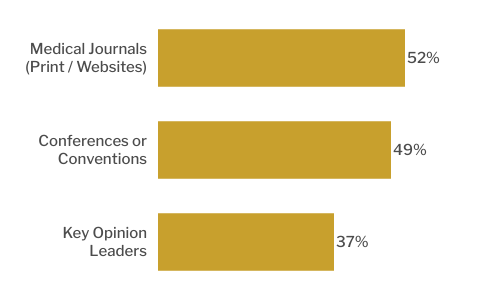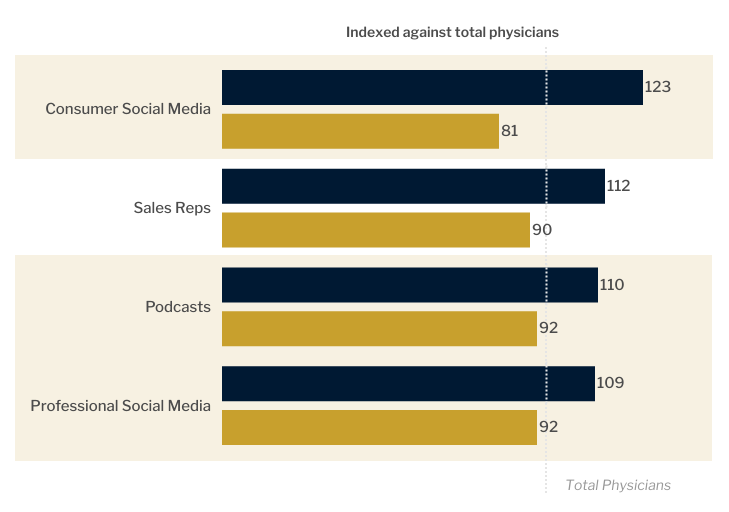Beyond Reach
Why Media Strategy Must Connect with Physician Messaging Preferences

Physicians are being inundated with information from countless sources: colleagues, advertising, CME, patients and more.
M3 MI’s latest Sources & Interactions + Digital Insights study shows that physicians prefer different media channels depending on the type of content being delivered, whether it’s clinical updates, product information, or patient education.
For healthcare marketers, this underscores a critical imperative – delivering the right message through the right channel is key. Healthcare marketers need to utilize data to bring together media and creative agencies for a collective approach with physician preferences at the center. Tailoring communication strategies to align with physicians’ preferences can not only enhance engagement but may drive more meaningful outcomes across the board.
In this article, we explore physician preferences for the messaging they prefer to receive through both traditional and emerging channels, drawing on insights from the 2025 Sources & Interactions + Digital Insights study.
Physicians’ Preferred Channels for Healthcare Messaging
Preferred Channels for Receiving Efficacy Data
89% of physicians’ treatment decisions are influenced by scientific data. When seeking information on a treatment’s efficacy, including its benefits and risks, physicians prefer trusted expert sources delivered through traditional channels such as medical journals, conferences, and key opinion leaders (KOLs).

Oncologists & Hem/Oncs are 60% more likely than total physicians to prefer efficacy data via online video
Preferred Channels for Learning About New Products, Procedures, or Innovations
When it comes to learning about new product information, physicians’ channel preferences vary depending on their tendency to adopt new drugs, devices, or procedures. Early adopters are more likely than physicians overall to prefer receiving this information through emerging channels such as social media and podcasts.
- Early adopters
(As soon as it is released or after a few successfully tries)
- Traditionalists
(Once it’s use is common or after it becomes standard)

Source: M3 MI’s 2025 Sources & Interactions + Digital Insights Study
Preferred Channels for Patient Education and/or Coverage Information*
A third of physicians’ treatment decisions are influenced by available patient education materials and nearly three quarters are influenced by knowing the treatment is covered by their patient’s healthcare plan. Physicians prefer to access this information directly from Pharma sources such as sales reps and pharma/device company websites.

On average, 60% of patients receive education/disease maintenance information
Information Physicians Want to Receive From Emerging Channels
Physicians prefer messaging from emerging channels that focuses on professional development, clinical knowledge, and medical innovations. Channels such as Podcasts, Online Video, and Social Media can offer shared experiences from their peers, a level of interactivity that is concise and credible, and information that is directly applicable to their practice.
-
Online Video
Continuing medical education (CME) 41%
Guidance on procedures 39%
-
Professional Social Media (Among those who use it)
Experiences of other physicians 54%
New products, procedures or innovations 36%
-
Podcasts (Among those who listen)
Deeper understanding of specific conditions 47%
New products, procedures or innovations 40%
As the healthcare landscape continues to evolve, understanding how physicians prefer to receive information is important for healthcare marketers. With insights from the 2025 Sources & Interactions + Digital Insights study, marketers have a unique opportunity to refine their strategies, delivering relevant, timely and impactful messaging through the channels physicians value.
By aligning the right content with their channel preference and placing physician needs at the center of planning, marketers can cut through the noise and create stronger, more meaningful connections that aim to support better patient care.
Source: M3 MI’s 2025 Sources & Interactions + Digital Insights Study
*Channels like to use for “patient or caregiver education/support materials” or “coverage, insurance and reimbursement” NET
Information
For more information on detailed study results from M3 MI, including at the specialty level, contact us at
info@M3-MI.com.